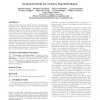Free Online Productivity Tools
i2Speak
i2Symbol
i2OCR
iTex2Img
iWeb2Print
iWeb2Shot
i2Type
iPdf2Split
iPdf2Merge
i2Bopomofo
i2Arabic
i2Style
i2Image
i2PDF
iLatex2Rtf
Sci2ools
ITICSE
2010
ACM
2010
ACM
PhidgetLab: crossing the border from virtual to real-world objects
Teaching pupils the ideas behind objects in programming languages can be difficult since these concepts are mostly and not comprehensible at first sight. Etoys as a visual programming environment counters such issues by introducing visible objects and simple tiles for programming them. However, all of these objects can only be experienced virtually on the screen. This paper presents PhidgetLab, a programming environment for electronic components (Phidgets) realised on top of the Etoys environment. PhidgetLab helps crossing the border from virtual to real-world objects. Pupils interact with tangible objects that are seamlessly connected to the digital world. PhidgetLab was evaluated in a case study with 22 pupils, following the principles of the Design Thinking methodology and comprised the realisation of five prototypes within a short period of time. Categories and Subject Descriptors K.3.1 [Computers and Education]: Computer Uses in Education—Collaborative learning; K.3.2 [Comput...
ITICSE 2010 | Programming Environment | Programming Environment Counters | Theoretical Computer Science | Visible Objects |
| Added | 02 Aug 2010 |
| Updated | 02 Aug 2010 |
| Type | Conference |
| Year | 2010 |
| Where | ITICSE |
| Authors | Michael Haupt, Michael Perscheid, Robert Hirschfeld, Lysann Kessler, Thomas Klingbeil, Stephanie Platz, Frank Schlegel, Philipp Tessenow |
Comments (0)

